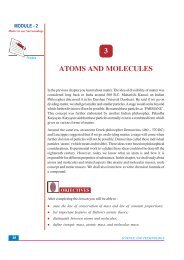NIOS : The Way Forward - The National Institute of Open Schooling
NIOS : The Way Forward - The National Institute of Open Schooling
NIOS : The Way Forward - The National Institute of Open Schooling
You also want an ePaper? Increase the reach of your titles
YUMPU automatically turns print PDFs into web optimized ePapers that Google loves.
<strong>NIOS</strong>: <strong>The</strong> <strong>Way</strong> <strong>Forward</strong> / 59<br />
steps to run an educational channel through DTH (Direct to Home) for reaching<br />
out to its students not only at their study centres but also at their homes.<br />
6.12.5 Videoconferencing<br />
This technology allows exchange <strong>of</strong> not just voice and graphics but also moving<br />
images. Videoconferencing technology does not use telephone lines but it<br />
uses either a satellite link or television network (broadcast/cable). Web-based<br />
conferencing, as the name implies, involves the transmission <strong>of</strong> text, and<br />
graphic, audio and visual media via Internet. It requires the use <strong>of</strong> a computer<br />
with a browser and communication can be both synchronous and<br />
asynchronous. In this context, the possibility <strong>of</strong> using the EDUSAT network in<br />
the country shall be explored.<br />
6.12.6 Mobile Computing<br />
Mobile computing is a technology that helps the user to connect the computer<br />
to network anytime and anywhere. This technology actually caters to the needs<br />
<strong>of</strong> users who ask for mobility and portability in using their computers. As<br />
notebook computers (laptops) became more and more affordable and useful,<br />
the number <strong>of</strong> laptop users has increased rapidly. <strong>The</strong> multiple connectivity<br />
through mobile technology will help the student to have updated information<br />
from <strong>NIOS</strong> related to their course work.<br />
6.12.7 Community Radio<br />
Community Radio has become an effective and economical means for reaching<br />
out to persons in far flung areas as well as to those who have a common area<br />
<strong>of</strong> interest. In this case learners <strong>of</strong> <strong>NIOS</strong> can easily be connected to each<br />
other and to <strong>NIOS</strong> RC or HQ through the community radio network. <strong>The</strong><br />
modalities <strong>of</strong> this can be worked out and the possibility <strong>of</strong> setting up a<br />
community radio station at <strong>NIOS</strong> learning network can be taken up.<br />
Commonwealth Educational Media Centre for Asia (CEMCA) has already<br />
<strong>of</strong>fered to collaborate with <strong>NIOS</strong> in this project.<br />
6.13 Education <strong>of</strong> Special Disadvantaged Groups<br />
6.13. 1 Education <strong>of</strong> Minorities<br />
<strong>NIOS</strong> has been mandated by the Government <strong>of</strong> India to provide educational<br />
access to all those who are outside the formal school system i.e.; to “reach<br />
the unreached”. Within the “unreached”, <strong>NIOS</strong> has its prioritized target<br />
groups comprising <strong>of</strong> marginalized groups, namely, rural youths, girls and<br />
women, SCs/STs, and differently abled learners street children etc.<br />
Although the cumulative enrolment <strong>of</strong> <strong>NIOS</strong> has been increasing in absolute<br />
terms, the proportional representation <strong>of</strong> these prioritized target groups has<br />
remained more or less static over last one and a half decades. It has been<br />
observed that within the educationally unreached categories, women in general,

















